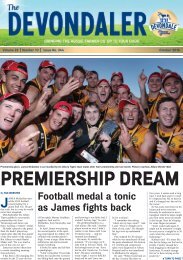You also want an ePaper? Increase the reach of your titles
YUMPU automatically turns print PDFs into web optimized ePapers that Google loves.
10<br />
MARCH <strong>2015</strong><br />
DEVONDALE MURRAY GOULBURN<br />
From bottom to top in BMCC figures<br />
By SUE WEBSTER<br />
PETER and Kate Norris<br />
took a herd with a Bulk<br />
Milk Cell Count (BMCC)<br />
averaging more than 800,000<br />
and within two years got it into<br />
premium band.<br />
Initially ranked in the bottom<br />
10 per cent regionally, their 10-<br />
day average by mid last year was<br />
124,000 – placing them in the<br />
top 13 per cent.<br />
The Inverloch sharefarmers<br />
tackled udder health as the first<br />
focus of the South Gippsland<br />
farm they took over in May<br />
2012.<br />
But then the rain came. And<br />
came. And came. In their first<br />
year, the 155ha farm scored<br />
more than a metre of rain.<br />
Mildura-born Kate couldn’t<br />
believe it.<br />
“I kept saying ‘we’re dairy<br />
farmers, not rice growers!’”<br />
They were determined to send<br />
the cell count southwards and<br />
received a lot of help from Field<br />
Services Officers, Jol Dutton and<br />
Tim Cross from the Devondale<br />
Murray Goulburn Leongatha<br />
factory.<br />
“They could see we were trying<br />
to get the count down and<br />
helped in any way they could.”<br />
So, what did they do? Kate<br />
rattled off the list. Blanket dry<br />
cow treatment with selective<br />
treatment for cows with more<br />
than 750,000 BMCC, blanket<br />
teat sealant, optimum feed management<br />
and mechanical work<br />
such as changing liners twiceyearly.<br />
“One of my favourite sayings<br />
is, ‘Look after the cows and<br />
they will look after you,’” Peter<br />
said.<br />
Over the same period they<br />
eased off their stocking rate,<br />
reducing the herd of 350 milkers<br />
to 300 in the first year, before<br />
lifting the numbers to 320 this<br />
year.<br />
Running fewer milkers and<br />
improving feed saw a 20 per<br />
Inverloch suppliers, Peter and Kate Norris, have have shown that hard work and determination can<br />
get you to the top of the table in milk quality.<br />
cent production lift with 40<br />
fewer cows.<br />
“And with better milk price<br />
increases we saw a 150 per cent<br />
increase in farm income,” Peter<br />
said.<br />
Kate recalled: “For two years<br />
we’ve had to keep our heads<br />
above water – quite literally – to<br />
get the cattle to where we’d like<br />
them to be. Now it’s time to<br />
bring the farm up as well.”<br />
The herd is now “a bit of<br />
everything, Friesian dominant<br />
with a Jersey influence.” In 2014<br />
they had 60 heifers calving and a<br />
herd in-calf rate of 85.5 per cent.<br />
They are breeding for longevity<br />
and for good temperament.<br />
They are milked through a 30-<br />
a-side swingover shed with auto<br />
cup removers.<br />
They are fed 7kg wheat in the<br />
bail and average<br />
1.95kgMS/cow/day at 3.63 protein<br />
and 4.41 fat.<br />
The paddocks are sown to<br />
Crusader ryegrass and they conserve<br />
around 600 rolls of pasture<br />
silage and 103 hay rolls.<br />
Farm financial performance is<br />
fundamental to this enterprise.<br />
The couple has projected next<br />
year’s income and are drafting a<br />
budget.<br />
Peter said: “One of the biggest<br />
influences that I’ve had is a<br />
Dutch farmer who told me the<br />
biggest thing is to know your<br />
costs and know your income.”<br />
Kate added: “Have breakfast<br />
with your budget.”<br />
And Peter added: “Manure.<br />
You’re always in it. It’s just a<br />
matter of degree.”<br />
It’s the sort of insight born of<br />
tough times, and they’ve known<br />
a few.<br />
The toughest period was possibly<br />
when the pair moved from<br />
the Yarra Valley, where Peter<br />
was raised and worked as a<br />
farmhand, to northern Victoria –<br />
via a stint as an agricultural<br />
contractor.<br />
They arrived in the northern<br />
irrigation region to manage a<br />
1000-cow herd during a prolonged<br />
drought. Peter was in<br />
charge of operations.<br />
Kate, holding a University of<br />
Melbourne Agricultural Science<br />
Degree, worked as herd<br />
manager.<br />
She has also acquired a<br />
Certificate IV in training and<br />
assessment since graduation<br />
and is currently completing a<br />
double diploma in management<br />
and human resource<br />
management.<br />
Peter has built his career from<br />
the bottom up and is currently<br />
formalising his knowledge<br />
through the skills recognition<br />
offered by National Centre for<br />
Dairy Education.<br />
Kate said: “Neither of us<br />
could do this job on our own.<br />
We both bring skills to the table<br />
that complement each other and<br />
I love working alongside my<br />
husband every day.”<br />
It’s been a big journey for a<br />
young couple with no dairy in<br />
their upbringing.<br />
The pair was introduced by a<br />
mutual friend when Kate was<br />
looking for work experience.<br />
“I think we were matchmakered,”<br />
she admitted.<br />
And if she hadn’t have met<br />
Peter?<br />
“I probably would have gone<br />
back to Mildura and gone into<br />
beef production.”<br />
But she didn’t. The result?<br />
Two children, Aimee, 9, and<br />
Alasdair, 6.




